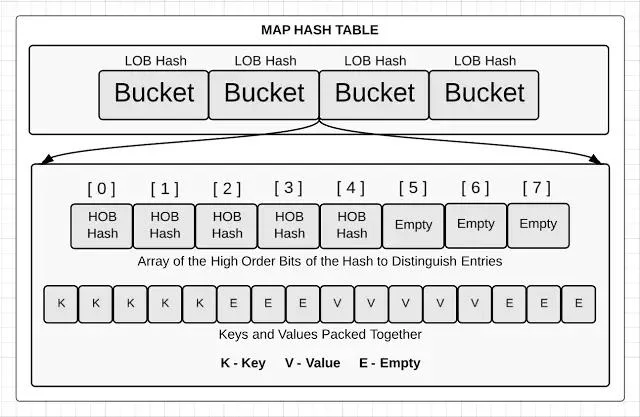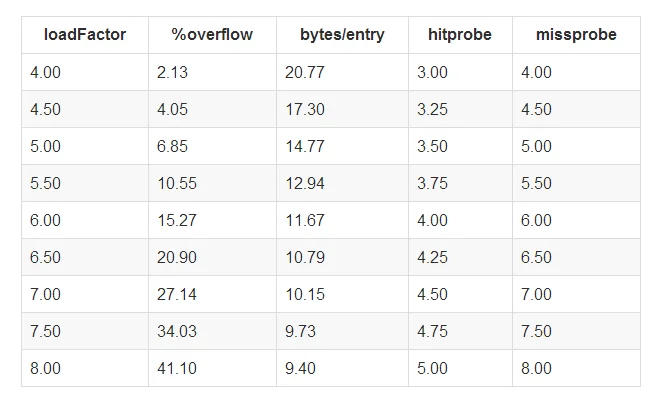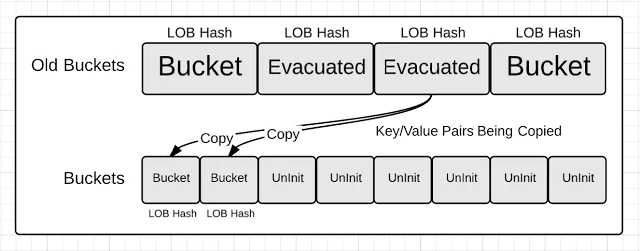原作者丨icexin(饼干)
基本语法定义hashmap变量
由于go语言是一个强类型的语言,因此hashmap也是有类型的,具体体现在key和value都必须指定类型,比如声明一个key为string,value也是string的map,
需要这样做
var m map[string]string // 声明一个hashmap,还不能直接使用,必须使用make来初始化
m = make(map[string]string) // 初始化一个map
m = make(map[string]string, 3) // 初始化一个map并附带一个可选的初始bucket(非准确值,只是有提示意义)
m := map[string]string{} // 声明并初始化
m := make(map[string]string) // 使用make来初始化
大部分类型都能做key,某些类型是不能的,共同的特点是:不能使用==来比较,包括: slice, map, function
get,set,delete
m := map[string]int
m["a"] = 1
fmt.Println(m["a"]) // 输出 1
// 如果访问一个不存在的key,返回类型默认值
fmt.Println(m["b"]) // 输出0
// 测试key是否存在
v, ok := m["b"]
if ok {
...
}
// 删除一个key
delete(m, "a")
迭代器
// 只迭代key
for k := range m {
...
}
// 同时迭代key-value
for k, v := range m {
...
}
在迭代的过程中是可以对map进行删除和更新操作的,规则如下:
- 迭代是无序的,跟插入是的顺序无关
- 迭代的过程中删除一个key,无论遍历还是没有遍历过都不会再遍历到
- 迭代的过程中添加一个key,不确定是否能遍历到
- 未初始化的map也可以迭代
其他
- map的value是不可取地址的,意味着 &m["a"]这样的语法是非法的
- len和cap分别可以获取当前map的kv个数和总容量
hashmap结构
golang的map是hash结构的,意味着平均访问时间是O(1)的。同传统的hashmap一样,由一个个bucket组成:

// A header for a Go map.
type hmap struct {
// Note: the format of the Hmap is encoded in ../../cmd/internal/gc/reflect.go and
// ../reflect/type.go. Don't change this structure without also changing that code!
count int // # live cells == size of map. Must be first (used by len() builtin)
flags uint8
B uint8 // log_2 of # of buckets (can hold up to loadFactor * 2^B items)
hash0 uint32 // hash seed
buckets unsafe.Pointer // array of 2^B Buckets. may be nil if count==0.
oldbuckets unsafe.Pointer // previous bucket array of half the size, non-nil only when growing
nevacuate uintptr // progress counter for evacuation (buckets less than this have been evacuated)
// If both key and value do not contain pointers and are inline, then we mark bucket
// type as containing no pointers. This avoids scanning such maps.
// However, bmap.overflow is a pointer. In order to keep overflow buckets
// alive, we store pointers to all overflow buckets in hmap.overflow.
// Overflow is used only if key and value do not contain pointers.
// overflow[0] contains overflow buckets for hmap.buckets.
// overflow[1] contains overflow buckets for hmap.oldbuckets.
// The first indirection allows us to reduce static size of hmap.
// The second indirection allows to store a pointer to the slice in hiter.
overflow *[2]*[]*bmap
}
bucket内部

// A bucket for a Go map.
type bmap struct {
tophash [bucketCnt]uint8
// Followed by bucketCnt keys and then bucketCnt values.
// NOTE: packing all the keys together and then all the values together makes the
// code a bit more complicated than alternating key/value/key/value/... but it allows
// us to eliminate padding which would be needed for, e.g., map[int64]int8.
// Followed by an overflow pointer.
}
根据一个key得到value
func mapaccess1(t *maptype, h *hmap, key unsafe.Pointer) unsafe.Pointer
- *maptype为map的类型信息,是编译器在编译期静态生成的,里面包含了map的一些元信息,比如key和value的类型信息等等
- *hmap为map的header,即map的引用
- key是一个通用的指针,代表了key的引用
- 返回值为一个指针,指向对应的value引用
hash计算找到bucket
那我们怎么访问到对应的bucket呢,我们需要得到对应key的hash值

alg := t.key.alg
hash := alg.hash(key, uintptr(h.hash0))
m := uintptr(1)<<h.B - 1
b := (*bmap)(add(h.buckets, (hash&m)*uintptr(t.bucketsize)))
根据tophash和key定位到具体的bucket
- tophash可以快速试错,如果tophash不相等直接跳过
- tophash相等的话,根据key的比较来判断是否相等,如果相等则找到
- 如果当前bucket都试玩还没有找到,则调到下一个bucket

- %overflow 溢出率,平均一个bucket有多少个kv的时候会溢出
- bytes/entry 平均存一个kv需要额外存储多少字节的数据
- hitprobe 找到一个存在的key平均需要找几下
- missprobe 找到一个不存在的key平均需要找几下
目前采用的是这一行:
| 6.50 | 20.90 | 10.79 | 4.25 | 6.50 |
迁移
更多精彩:
Goalng 实战课程优惠进行中……
Golang 技术交流群:426582602

